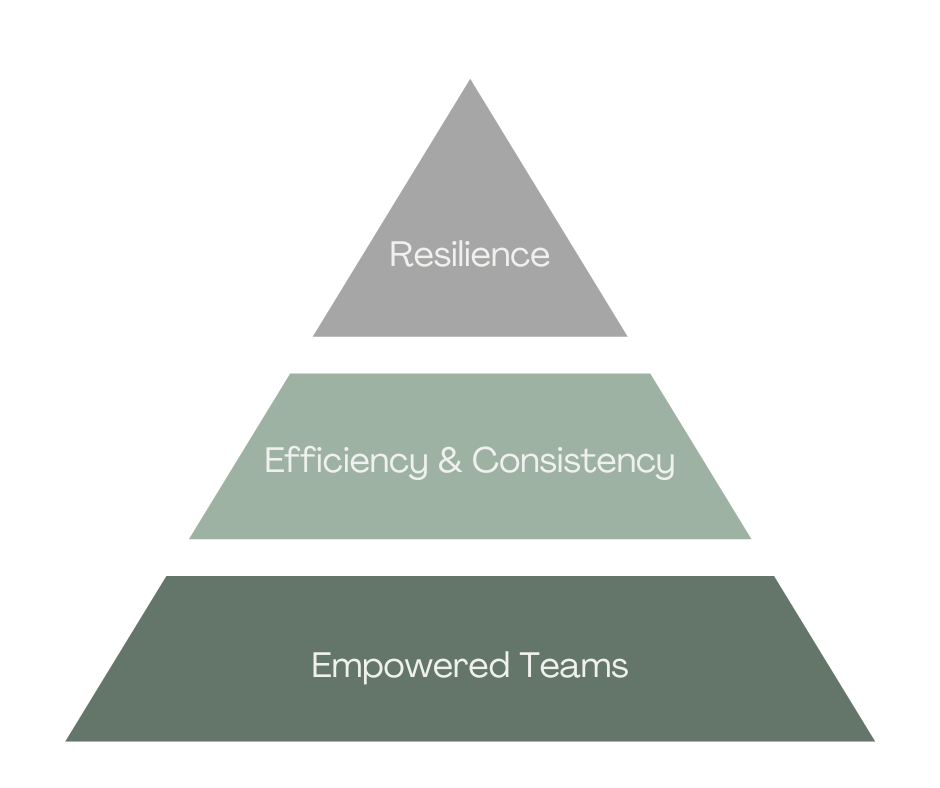Creating Lasting Scale: The Foundations For Sustainable Growth
When we talk about scaling a business, it’s easy to picture rapid growth—more customers, more revenue, and a bigger team. But true, lasting scale is about much more than just getting bigger. It’s about building a business that grows sustainably without sacrificing quality, customer satisfaction, or the well-being of your team.
Let’s break down what lasting scale really means and the core characteristics that make it possible.
What Is Lasting Scale?
Lasting scale is the ability of your business to grow in a healthy, manageable way—where success doesn’t come at the cost of your people, your standards, or your sanity. It’s about creating a business that can handle growth without falling apart, burning out the team, or letting standards slip.
In simple terms:
A business with lasting scale grows steadily, keeps customers happy, and looks after its people—no matter how big it gets.
The Four Core Characteristics of Lasting Scale
To achieve lasting scale, there are four key characteristics every business should focus on:
1. Efficiency
What it means:
Efficiency is about streamlining your operations so every action adds value, and nothing is wasted. It’s not just about speed—it’s about making sure every step in your process is necessary and effective.
How to achieve it:
- Map your processes: Break down every workflow, from sales to customer service, and identify bottlenecks or repetitive tasks.
- Automate where possible: Use technology to handle routine tasks, freeing your team to focus on high-value work.
- Continuous improvement: Encourage feedback from your team on what’s working and what isn’t. Regularly review and refine your processes.
Real-world example:
A growing consultancy mapped out their client onboarding process and found that automating document collection saved them hours each week—time they could spend building client relationships.
Quick tip:
Ask yourself: “If we doubled our workload tomorrow, would our current processes cope?” If not, it’s time to streamline.
2. Consistency
What it means:
Consistency is about making sure every customer gets the same high-quality experience, every time. It’s the difference between a one-off win and building a trusted brand.
How to achieve it:
- Standard operating procedures (SOPs): Document the steps for key tasks so everyone’s on the same page.
- Quality checks: Build in regular reviews—whether it’s a checklist before delivery or a peer review of work.
- Training: Invest in regular training so your team knows exactly how to deliver your standards.
Real-world example:
A national bakery grew from ten shops to twenty-five by creating clear recipes and training guides, so every loaf and pastry tasted the same, no matter who was baking.
Quick tip:
Think about the last time a customer said, “This is exactly what I expected.” That’s consistency in action—aim for it every time.
3. Resilience
What it means:
Resilience is your ability to weather storms—market shifts, supply chain hiccups, or sudden changes in demand—without losing momentum or morale.
How to achieve it:
- Scenario planning: Regularly ask, “What if?” and have plans in place for common risks.
- Diversify: Don’t rely on just one product, supplier, or client. Spread your risk.
- Build a supportive culture: Encourage open communication so your team feels comfortable sharing challenges early.
Real-world example:
During a market downturn, a design agency shifted focus from hospitality clients to tech startups, using their adaptable processes to quickly serve a new market.
Quick tip:
Schedule a quarterly “what if” session with your team to brainstorm risks and solutions. Being prepared is half the battle.
4. Empowered Teams
What it means:
Empowered teams are made up of people who know their roles, are trusted to make decisions, and feel their contributions matter. This isn’t about micro-managing; it’s about giving your team the confidence and clarity to take ownership.
How to achieve it:
- Clear roles and responsibilities: Make sure everyone knows what’s expected of them—and who to turn to for support.
- Open communication: Create a culture where questions and ideas are welcomed.
- Recognition and growth: Celebrate wins and invest in developing your people’s skills.
Real-world example:
A software company introduced weekly check-ins where team members could share successes and challenges. Morale soared, and so did productivity.
Quick tip:
Ask your team, “What would help you do your job better?” and act on what you hear. Small changes can make a big difference.
Bringing It All Together
When you focus on efficiency, consistency, resilience, and empowered teams, you’re not just building a business that can grow—you’re building one that can thrive for years to come. These aren’t just buzzwords—they’re practical principles you can apply, one step at a time.
Visualising Lasting Scale: The Pyramid Model
To make this easy to remember, picture a pyramid:
- Base: Empowered Teams—your foundation.
- Middle Layers: Efficiency and Consistency—your systems and standards.
- Top: Resilience—your ability to adapt and thrive.
Empowered teams are at the bottom because nothing else works without them. Build your business on a strong foundation of people who know what’s expected and feel supported, and you’ll be able to layer on efficient processes, consistent results, and resilience at the top.

In Summary
Lasting scale isn’t just about getting bigger—it’s about getting better as you grow. By focusing on efficiency, consistency, resilience, and, most importantly, empowered teams, you’ll set your business up for sustainable, healthy growth that stands the test of time.
Takeaway Checklist: Is Your Business Ready for Lasting Scale?
- Are your processes efficient and easy to scale?
- Do you deliver consistent results every time?
- Can your business adapt quickly to change?
- Does your team feel empowered and supported?
If you answered “no” to any of these, start there—lasting scale is built one step at a time.
Ready to map your process for lasting scale? Let’s start building your foundation today.

